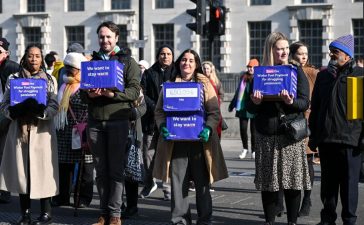
© Reuters. FILE PHOTO: A shop assistant counts piles of British Pound Sterling banknotes at an Apple store in London, Britain November 18, 2017. REUTERS/Russell Boyce
By Lucy Raitano
LONDON, Mar 1 (Reuters) – rose marginally against a weaker dollar on Wednesday, trimming gains made earlier in the session after Bank of England Governor Andrew Bailey said nothing had been decided in terms of whether interest rates would need to rise again.
By 1130 GMT, the pound was 0.1% higher against the dollar at $1.20310, having traded as much as 0.6% higher before Bailey spoke. The currency also fell to a one-week low against the euro, down 0.72% at 88.615 pence.
In the text of a speech he was due to give at a conference, Bailey cautioned against the idea that either the central bank has finished raising rates, or that it will inevitably need to do more.
His comments prompted traders to slightly trim their bets on the likelihood of a 25 bps rate increase when the BoE meets on March 23 for its next policy meeting, although this is still seen as the most likely outcome.
“I am surprised that markets are reading so much into it, though it’s probably exaggerated by the fact that we’ve had such a good move in sterling through the course of the week so far,” said Adam Cole, head of FX strategy at RBC Capital Markets.
Cole said that sterling has been helped by the announcement earlier in the week of a deal with the European Union to amend the original Northern Ireland Protocol, which on Monday lifted the pound to its biggest daily gain against the dollar in six weeks.
The bank rate presently stands at 4% after 10 consecutive rate increases by the BoE since late 2021. Markets still see rates rising to 4.75% in the second half of this year.
On the data front, latest figures from mortgage lender Nationwide showed British house prices dropping by the most in more than 10 years in February, a further signal of a housing market slowdown and economic gloom facing the country.
“There is a dichotomy in the data where the corporate indicators have turned a bit better, PMIs in particular,” said Cole.
“But data for households is not getting any better, and still point to further weakness in the first half of the year.”











